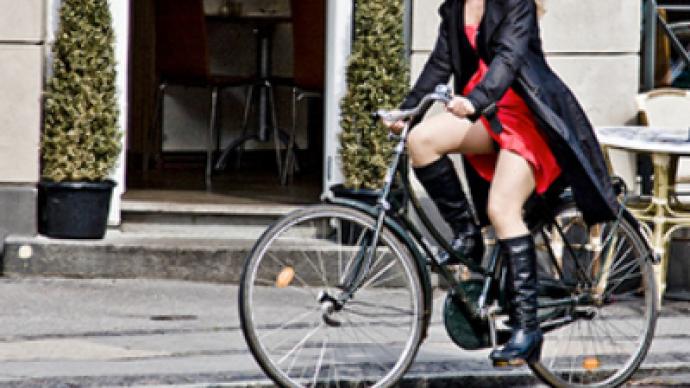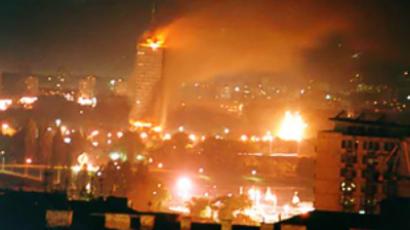Pedestrian paradise: urban jungles minus the cars

Moscow joins cities across Europe as it endorses a "day without cars" that gives pedestrians - and motorists - a vision of what their city might be like without the internal combustion engine.
According to the website of the UK Department of Transport, the car-free initiative, which is held every Sept. 22, is designed to allow people to “question what out town centre streets are really for, and whether we have got the balances right between the differing and often competing needs of the street users.”
In short, Europe’s car-free initiative is designed to give priority to people over traffic. After all, cities did quite fine before the advent of the automobile, albeit with horse-manure minefields to maneuver around, so there is no reason urban areas could not flourish today without the scourge of vehicles. What is lacking, advocates say, is a new way of thinking about urban planning. This is critical, they say, because the very survival of the city as a viable social entity may hinge in the balance.
Brussels, the administrative heart of the EU, seems to loathe the automobile more than any of its European cousins: According to Belgian media, 32 towns and cities across the city banished cars and trucks from their streets as part of European Mobility Week (Sept. 16-22), yet another EU initiative aimed at popularizing other forms of transportation.
Belgian towns and cities including Antwerp, Bruges, Ghent, and Mechelen were all free of traffic on Sunday, two days before CFD.
To calm the angst of all those motorists who must suddenly find another mode of transport, the Belgian authorities announced that all forms of public transportation would be free of charge.
Wheel-less in Moscow?
So how did Muscovites respond to the call to leave their beloved cars at home and utilize other forms of transportation? The general response to the initiative could best be summarized by a comment from a Moscow-based journalist who said the plan gave him hope because “maybe I won’t get stuck in any traffic jams tomorrow morning.”
It must be added, however, that a bicycle rally took place at the Moscow State University on Tuesday evening that attracted a fair share of "pro-pedal" enthusiasts.
One of the participants, Gretchen Faronne, a law student from Paris, said she was pleasantly surprised to discover that young Muscovites were thinking about the "plight of the planet" and the adverse effects that cars are having on the climate.
"I have been living here for over a month now," Faronne said, "and I was really surprised that the Russians I have met are seriously thinking about the health of the planet – and the health of the humans, because all these cars are affecting our health, too, not just Earth's."
Although Moscow – Europe’s most-populated city – has no shortage of alternative public transport for the masses (its underground subway system, for example, is one of the busiest and most efficient in the world), its new power-spending middleclass has grown accustomed to the freedom and comfort the coveted car provides, even though this “freedom” usually means sitting in snarling gridlock morning and night.
Tverskaya Ulitsa, the main boulevard that slices its way through the heart of the Russian capital, is a six-lane raging river of metal, glass and rubber. The boulevard is so wide across, and so tricky to negotiate, that special underground passageways have been built that allow pedestrians to cross without risking life and limb. On this score, Moscow must be congratulated for this truly pedestrian-friendly idea, which certainly involved no small cost. But such plans, commendable as they are, fall short of actually reducing the number of cars in the city.
The historical and architecturally blessed street, Kamergersky, which cuts across Tverskaya just before the Kremlin, was permanently closed to all traffic several years ago. Today, Kamergersky is a quiet, quaint, cobblestoned promenade, complete with streetlamps and springtime patios. Gone is the incessant roar of traffic and all of the problems that the metal monsters entail, including air and noise pollution levels that are off the charts. Interestingly, businesses, which usually are the first to complain about any anti-automobile initiatives, seem to be enjoying a booming business.
The manager of a local theater reported that “closing the street (Kamergersky) was the wisest decision the city officials ever made. We have more business now than ever before.”
And once every blue moon, a Russian holiday occurs that is deemed significant enough to bring the torrent of steel to a halt along Tverskaya as the street is closed off to all traffic. On this day, Muscovites and tourists come out in droves to take advantage of the wide-open thoroughfare without the sound and the fury of the mighty machines.
As a great throng of people substitutes for the daily traffic jam, or military parade, a single question hangs in the clear air: why don’t we close this street down everyday?
Yet Moscow, which has experienced an explosion in car ownership in just the last five to seven years, keeps laying down the asphalt in a seemingly futile effort to create more space for the automobile.
Desperate attempts to expand the 110-kilometer MKAD (Moskovskaya Koltsevaya Avtomobilnaya Doroga, or Moscow Automobile Ring Road), for example, which is comparable to Washington’s Beltway, and London’s M25, have not made a dent in Moscow’s worsening traffic situation.
Recently, less popular forms of alternative transportation, including the bicycle, are becoming increasingly popular, as Moscow businesses bow to the public demand for secure bike racks and scooter spots. Even the dangerous motorcycle has made a roaring comeback. Well, it's a start.












